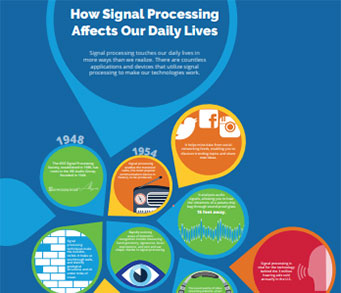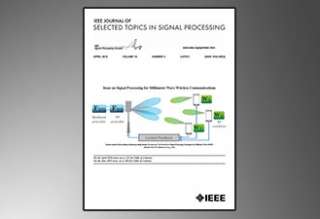SPS Feed
Top Reasons to Join SPS Today!
1. IEEE Signal Processing Magazine
2. Signal Processing Digital Library*
3. Inside Signal Processing Newsletter
4. SPS Resource Center
5. Career advancement & recognition
6. Discounts on conferences and publications
7. Professional networking
8. Communities for students, young professionals, and women
9. Volunteer opportunities
10. Coming soon! PDH/CEU credits
Click here to learn more.
The Latest News, Articles, and Events in Signal Processing
Submission Deadline: July 15, 2019
Call for Proposals Document

The Chair of Theoretical Information Technology at the Technical University of Munich has an immediate opening for a
Doctoral student; Postdoctoral student:
Hardware Demonstrator for Post Shannon Communication (E13 TVL) (f/m/d)
A critical task of a radar receiver is data association, which assigns radar target detections to target filter tracks. Motivated by its importance, this paper introduces the problem of jointly designing multiple-input multiple-output (MIMO) radar transmit beam patterns and the corresponding data association schemes.
This paper reformulates adaptive filters (AFs) in the framework of geometric algebra (GA), developing a complete study of the resulting geometric-algebra adaptive filters (GAAFs). They are generated by formulating the underlying minimization problem (a deterministic cost function) from the perspective of GA, a comprehensive mathematical language well suited for the description of geometric transformations.
We exploit persymmetric structures to design a generalized likelihood ratio test for detecting subspace signals in homogeneous Gaussian clutter with unknown covariance matrix. The subspace model is employed to account for mismatches in the target steering vector. An exact but finite-sum expression for the probability of false alarm of the proposed detector is derived, which is verified using Monte Carlo simulations.
The robust adaptive beamforming design problem based on estimation of the signal-of-interest (SOI) steering vector is considered in the paper. The common criteria to find the best estimate of the steering vector are the beamformer output signal-to-noise-plus-interference ratio (SINR) and output power, while the constraints assume as little as possible prior inaccurate knowledge about the SOI, the propagation media, and the antenna array.
We consider the problem of jointly recovering the vector
In this paper, we address the problem of recovering point sources from two-dimensional low-pass measurements, which is known as the super-resolution problem. This is the fundamental concern of many applications such as electronic imaging, optics, microscopy, and line spectral estimations. We assume that the point sources are located in the square
In this paper, we bridge the problem of (provably) learning shallow neural networks with the well-studied problem of low-rank matrix estimation. In particular, we consider two-layer networks with quadratic activations, and focus on the under-parameterized regime where the number of neurons in the hidden layer is smaller than the dimension of the input.
In this paper, we aim at designing sets of binary sequences with good aperiodic/periodic auto- and cross-correlation functions for multiple-input multiple-output (MIMO) radar systems. We show that such a set of sequences can be obtained by minimizing a weighted sum of peak sidelobe level (PSL) and integrated sidelobe level (ISL) with the binary element constraint at the design stage.

The Signal Processing research group at the Universität Hamburg (http://uhh.de/inf-sp) is hiring a PhD student or a postdoctoral researcher for 33 months for the project "Crossmodal Processing of Audio-Visual Signals".
Please find further information here:
Lecture Date: October 14, 2019
Chapter: SPS Twin City Chapter
Chapter Chair: Tao Zhang
Topic: Array processing and beamforming with Kronecker products
Manuscript Due: December 1, 2019
Publication Date: August 2020
CFP Document
Manuscript Due: September 15, 2019
Publication Date: May 2020
CFP Document
Lecture Date: October 15, 2019
Chapter: Thailand
Chapter Chair: Supavadee Aramvith
Topic: Data Fusion Through Matrix and Tensor Factorizations:
An Overview of Solutions, Challenges, and Prospects
Photometric stereo is a method that seeks to reconstruct the normal vectors of an object from a set of images of the object illuminated under different light sources. While effective in some situations, classical photometric stereo relies on a diffuse surface model that cannot handle objects with complex reflectance patterns, and it is sensitive to non-idealities in the images.
This paper presents a new robust PCA method for foreground-background separation on freely moving camera video with possible dense and sparse corruptions. Our proposed method registers the frames of the corrupted video and then encodes the varying perspective arising from camera motion as missing data in a global model.
Camera-based face detection and verification have advanced to the point where they are ready to be integrated into myriad applications, from household appliances to Internet of Things devices to drones. Many of these applications impose stringent constraints on the form-factor, weight, and cost of the camera package that cannot be met by current-generation lens-based imagers.
The recently introduced Spatial Spectral Compressive Spectral Imager (SSCSI) has been proposed as an alternative to carry out spatial and spectral coding using a binary ON-OFF coded aperture. In SSCSI, the pixel pitch size of the coded aperture, as well as its location with respect to the detector array, plays a critical role in the quality of image reconstruction.
The adaptive algorithms applied to distributed networks are usually real-valued diffusion subband adaptive filter algorithms. However, it cannot be used for processing the complex-valued signals. In this paper, a novel augmented complex-valued diffusion normalized subband adaptive filter (D-ACNSAF) algorithm is proposed for distributed estimation over networks. In order to deal with the noncircular complex-valued signals, the D-ACNSAF algorithm uses the widely linear model for a diffusion network.
Pages
SPS Social Media
- IEEE SPS Facebook Page https://www.facebook.com/ieeeSPS
- IEEE SPS X Page https://x.com/IEEEsps
- IEEE SPS Instagram Page https://www.instagram.com/ieeesps/?hl=en
- IEEE SPS LinkedIn Page https://www.linkedin.com/company/ieeesps/
- IEEE SPS YouTube Channel https://www.youtube.com/ieeeSPS










